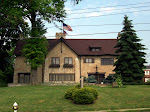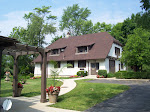The original, very first Arby’s Restaurant was located at 90 Boardman-Canfield Road (Route 224) at the corner of Route 224 and Amherst Avenue, the present location of the store Wild Birds Unlimited. Leroy and Forrest Raffel opened the restaurant July 23, 1964, selling it a year or so later to Sam Feldman. The name is from “RB” for Raffel Brothers. In 1965 the brothers followed up with opening a branch in Akron, Ohio. The Raffel Brothers, originally from New Castle, PA, were also in the restaurant supply business according to the Youngstown area city directories.
Corporate headquarters for Arby’s Inc. was located on Boardman Street, then along Rayen Avenue before moving to Colonial Drive and then Belmont Avenue. The corporation was purchased by Royal Crown Companies, Inc. in 1976 and the headquarters were moved out of the Mahoning Valley to Atlanta, GA by 1979.
Corporate headquarters for Arby’s Inc. was located on Boardman Street, then along Rayen Avenue before moving to Colonial Drive and then Belmont Avenue. The corporation was purchased by Royal Crown Companies, Inc. in 1976 and the headquarters were moved out of the Mahoning Valley to Atlanta, GA by 1979.

Morgan’s Wonder Boy Drive In Restaurant was located at 7240 Market Street, at the corner of Route 224, in the vicinity of what is now Circuit City (#7230) with Walgreens (#7295) across the street.










